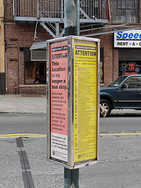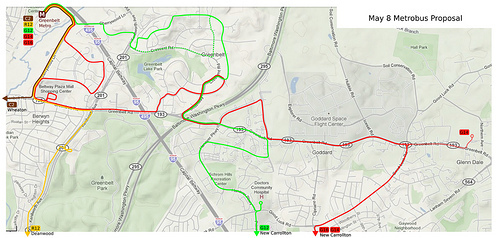‘Metrospeak’ camouflages bus cuts
Because of Metro’s budget shortfall, fares will likely rise, and some service reductions will take place. However, Metro’s terminology misleadingly couches major service reductions as “restructurings.”
General Manager Richard Sarles’ budget proposal calls for fewer bus cuts - certainly a fact worth celebrating. But some very major cuts remain. Many of the bus cuts are in northern Prince George’s County.
The agency’s use of “Metrospeak” is downplaying the service cuts proposed for the region in several ways. One such way is the use of net figures in the budget. For instance, GM Sarles’ budget includes $6.9 million in bus cuts. However, since Metro is adding service on several lines (to the tune of $2.6 million), Metro is claiming that there will only be a $4.3 million bus service cut.
That’s simply misleading. If I take $510,000 from Appleton and give $500,000 to Beechwood, I can’t say that I’m only cutting buses by $10,000. Because in this scenario, the people of Appleton are being asked to take a very severe cut, 50 times larger than $10,000. To be clear, Metro should use gross figures, not net figures.
According to Sarles’ budget, 14% of Metro’s bus service cuts are reductions on lines serving northern Prince George’s. Of course, many of the affected riders don’t know their routes are up for elimination, truncation, or reduction because large swaths of the region are named after only two places: Hyattsville and Greenbelt.
The “Greenbelt Restructuring” has serious implications for other communities outside of the city, notably Seabrook. Residents of Adelphi probably wouldn’t think to look at “Hyattsville Restructuring” when it comes to Metro eliminating much of their mobility. Moreover, the “Hyattsville Restructuring” involves communities as far away as Takoma Park, Silver Spring, and Hillandale, which aren’t even in the same county as Hyattsville.
The WMATA planning department is trying to reduce redundancy and improve the efficiency of several lines. And there is certainly room for improvement. As I reported several months ago, for instance, the R12 and T16/17 run together nose to tail on their common segments in Greenbelt, resulting in unnecessarily long headways.
Metro is calling all of the Greenbelt/Seabrook and Hyattsville/Adelphi cuts “restructurings”. The idea of restructuring is in improving efficiency. In a letter to TRU-G member John Stith, Metro planner Jim Hamre said that “by definition, restructuring will change (but not decrease) the service in the region.” And at the blogger meeting on Monday, I confirmed the understanding with another Metro staffer who was under the impression that Greenbelt would not be seeing any service reductions, only an improvement in efficiency.
But much of the savings comes from the elimination of the C2 from Greenbelt Center and the complete elimination of the R3. The C2 is the most frequent bus line in Greenbelt, offering rush hour service as frequently as every 13 minutes between the Metro and Greenbelt Center. It also offers direct service to the University of Maryland, Langley Park, and Wheaton. But what is even more outrageous is that, in Metro’s budget documents, the “Greenbelt Restructuring” is listed as affecting the R12, T16, and T17. The C2, which is facing the largest cuts, is not even listed.
When asked if Metro would even consider running only every other C2 bus to Greenbelt Center, a planner representing Metro said it seemed extremely unlikely. But without that bus line, Greenbelters and others will see cuts that far exceed any vestige of “restructuring”. In fact, the planner who spoke to Transit Riders United of Greenbelt on Saturday indicated that in the long term, Metro hopes to completely eliminate the Prince George’s County segment of the C2, instead having it terminate at Langley Park.
The R3’s elimination will take Sunday service away from many residents of Hyattsville and Adelphi, and will essentially transform the existing all-day service into rush hour only service during the week. The cutting of the F6 will leave Takoma and Silver Spring riders waiting longer at the stop each day. The loss of service between Hillandale and the University of Maryland is another major blow, as is turning the C8 into rush hour service only. And the C8 doesn’t even currently go to Hyattsville. It’s only listed under “Hyattsville Restructuring” because it’s proposed to be rerouted there. These aren’t restructurings; they’re slashings and burnings of the Metrobus network.
Metro is misleading riders, whether intentionally or not. Regardless, even some Metro employees don’t know what is being proposed because of the use of “Metrospeak.” How can we expect the Board to make an informed decision on budget cuts? What sounds like a vote to improve efficiency is actually a vote to make major bus cuts.
Improving efficiency in bus service is a laudable goal, and it’s long overdue. Few citizens would oppose a real move toward greater efficiency. But it is dishonest to call removing more than half of the buses serving a neighborhood a move toward efficiency. It’s dishonest to call elimination of Sunday service “restructuring.” And it’s dishonest to refer to bus routes spanning two counties by just one of the places they serve.


